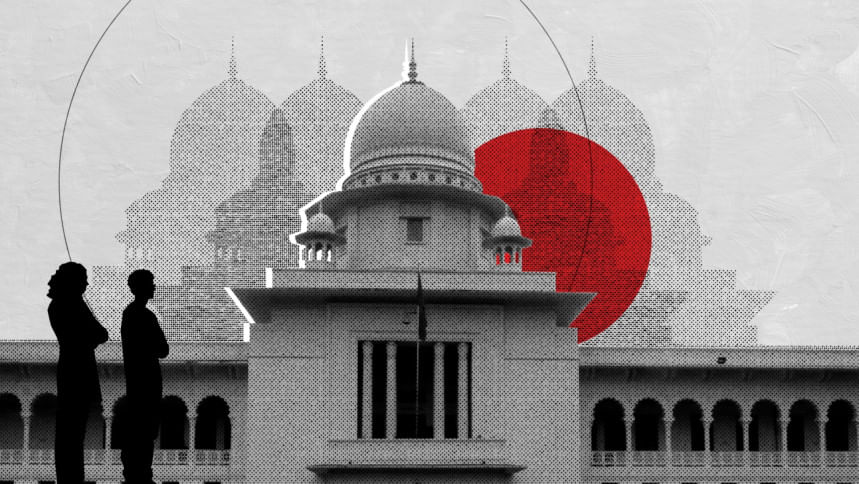From case backlog to justice: A practical blueprint for Bangladesh’s courts

The courts in Bangladesh are running on scarcity and delay. The docket contains above 45 lakh pending cases (as of December 31, 2024) and the judge-to-population ratio is among the weakest in South Asia. Women hold only 11 of 118 seats in the higher judiciary, which is neither fair nor smart management of national talent. These facts depict a structural failure that prices ordinary people out of timely justice and erodes public trust.
There have been some encouraging developments of late, however. The High Court recently restored the Supreme Court's authority over postings, promotions and discipline for the subordinate judiciary, and directed the government to create a separate judicial secretariat. This decision reconnects constitutional principle with operational control. But it will only work if the secretariat is staffed with planners, analysts and court managers who, among other long-overdue reforms, enforce a workforce plan that ties judge numbers to caseloads, retirements and expected filings by district. If it turns into another office that moves files rather than moving cases, the reform will die of bureaucracy.
Appointments must leave personal politics behind. The new Supreme Court Judges' Appointment Ordinance, 2025 establishes a council led by the chief justice. The council can raise quality and legitimacy if it publishes criteria, advertises vacancies, releases reasoned shortlists, and discloses how conflicts are managed. Without radical transparency, it risks becoming a new wrapper on an old practice. It should also set measurable goals for women's representation and state, in plain language, how caregiving breaks and family postings are treated so that merit is not gamed by gendered penalties.
Structure beats slogans. The government has now separated civil and criminal work at district level and created dedicated criminal courts. Specialisation helps only if it follows discipline. The Supreme Court should consider issuing binding practice directions that cap adjournments, fix hearing windows, and require each court to publish and meet a daily hearing capacity. That is how you turn policy into throughput. The cause list must be a contract with the public, not a wish list for tomorrow.
And digital must become the default. The judiciary already runs an electronic cause list, a litigant portal, electronic certified copies, a judicial payment gateway, and a monitoring dashboard. A company bench has begun paper-free proceedings. Make routine filings electronic by default, move service of process to verified digital channels with a physical fallback, and publish a monthly open-data release on filings, disposals, and age of cases by courts.
Civil procedure has finally been updated. The Code of Civil Procedure (CPC) was amended in May to cut dead time and quicken case flow. These textual changes must be translated into daily practice through directions that enforce time standards from summons to arguments, block serial adjournments without recorded exceptional reasons, and require early case conferences for complex matters.
Criminal delay needs its own toolkit. Create standing bail benches during peak seasons to stabilise custody numbers. Put police and forensic witnesses on day-certain schedules with automatic notices and proportionate penalties for absence. Use the law already on the books to divert minor matters. Compounding of offences exists under Section 345 of the Code of Criminal Procedure (CrPC), and it can be applied swiftly under judicial oversight. Bangladesh does not yet have a formal plea-bargaining regime, but policymakers can pilot structured plea discussions for defined non-violent offences with strict safeguards and recorded reasons, drawing on regional and domestic experience.
Alternative dispute resolution (ADR) is the unspent currency of reform. Section 89A of CPC makes court referral to mediation mandatory in civil suits, yet practice remains timid. India has enacted a dedicated Mediation Act, 2023, and is pushing institutional mediation. Bangladesh should pass a modern mediation law and ratify the Singapore Convention on Mediation to make internationally mediated settlements enforceable. The case for action has been made for years; it is time to move from seminars to signatures and from pilot rooms to default routes. Chief Justice Syed Refaat Ahmed has also notably emphasised the importance of ADR in the country.
Also, the bench environment needs to be professionalised. Every High Court judge should have a law clerk or judicial researcher. Every district judge should have a trained case manager certified by the Judicial Administration Training Institute (JATI). Expand JATI's mandate to cover modern scheduling, digital service, and dispute resolution training for case managers and list officers.
Moreover, it is crucial that access to courts is decentralised without fragmenting quality. The establishment of permanent High Court benches in divisional cities—which political parties agreed on during talks with the National Consensus Commission in early July—would cut cost and travel time for citizens while aligning appellate oversight with regional needs. Design is key here: a single digital registry and a unified listing system should be maintained so that practice standards stay consistent nationwide.
Clean governance is not optional. The scandals surrounding former chief justices remain a standing warning. Wealth declarations for judges every three years, published online with a clear review mechanism, would make integrity checks routine rather than performative. The Judiciary Reform Commission pressed for this, yet recent reports show how implementation stalled for years due to lack of rules. Draft the rule, publish the data, and act on irregularities. Trust grows when the system chooses light over shadows.
The huge case backlog in courts will not shrink by wish alone. Pair the above reforms with a surge plan. Contract retired district judges with proven track records on fixed terms to clear aged tranches of routine appeals and revisions under appellate supervision with public metrics. The Judiciary Reform Commission also recommended this. Publish district-wise targets for filings, disposals, and age of cases, and track clearance rates monthly in a dashboard accessible to citizens. Use the existing digital rails to make performance visible.
The path forward is now clear enough. In short, appoint more judges, and appoint them better. Bring more women to the top through transparent criteria and family-aware postings. Enforce time standards with real case management. Make digital the default. Turn ADR from theory into practice. Decentralise wisely. Open the books on assets and performance. Do all of this, and the case backlog will bend. But keep doing what we have been doing so far, and nothing will change except the number on the pending board. The choices we make today will determine whether justice will remain delayed, and denied in turn, or be delivered on time in the future.
Barrister Khan Khalid Adnan is advocate at the Supreme Court of Bangladesh, fellow at the Chartered Institute of Arbitrators, and head of the chamber at Khan Saifur Rahman and Associates in Dhaka.
Views expressed in this article are the author's own.
Follow The Daily Star Opinion on Facebook for the latest opinions, commentaries and analyses by experts and professionals. To contribute your article or letter to The Daily Star Opinion, see our guidelines for submission.

 For all latest news, follow The Daily Star's Google News channel.
For all latest news, follow The Daily Star's Google News channel. 











Comments